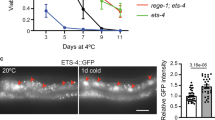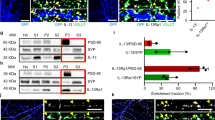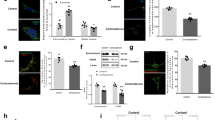Abstract
In the healthy adult brain synapses are continuously remodelled through a process of elimination and formation known as structural plasticity1. Reduction in synapse number is a consistent early feature of neurodegenerative diseases2,3, suggesting deficient compensatory mechanisms. Although much is known about toxic processes leading to synaptic dysfunction and loss in these disorders2,3, how synaptic regeneration is affected is unknown. In hibernating mammals, cooling induces loss of synaptic contacts, which are reformed on rewarming, a form of structural plasticity4,5. We have found that similar changes occur in artificially cooled laboratory rodents. Cooling and hibernation also induce a number of cold-shock proteins in the brain, including the RNA binding protein, RBM3 (ref. 6). The relationship of such proteins to structural plasticity is unknown. Here we show that synapse regeneration is impaired in mouse models of neurodegenerative disease, in association with the failure to induce RBM3. In both prion-infected and 5XFAD (Alzheimer-type) mice7, the capacity to regenerate synapses after cooling declined in parallel with the loss of induction of RBM3. Enhanced expression of RBM3 in the hippocampus prevented this deficit and restored the capacity for synapse reassembly after cooling. RBM3 overexpression, achieved either by boosting endogenous levels through hypothermia before the loss of the RBM3 response or by lentiviral delivery, resulted in sustained synaptic protection in 5XFAD mice and throughout the course of prion disease, preventing behavioural deficits and neuronal loss and significantly prolonging survival. In contrast, knockdown of RBM3 exacerbated synapse loss in both models and accelerated disease and prevented the neuroprotective effects of cooling. Thus, deficient synapse regeneration, mediated at least in part by failure of the RBM3 stress response, contributes to synapse loss throughout the course of neurodegenerative disease. The data support enhancing cold-shock pathways as potential protective therapies in neurodegenerative disorders.
This is a preview of subscription content, access via your institution
Access options
Subscribe to this journal
Receive 51 print issues and online access
$199.00 per year
only $3.90 per issue
Buy this article
- Purchase on Springer Link
- Instant access to full article PDF
Prices may be subject to local taxes which are calculated during checkout




Similar content being viewed by others
References
Holtmaat, A. & Svoboda, K. Experience-dependent structural synaptic plasticity in the mammalian brain. Nature Rev. Neurosci. 10, 647–658 (2009)
Selkoe, D. J. Alzheimer’s disease is a synaptic failure. Science 298, 789–791 (2002)
Mallucci, G. R. Prion neurodegeneration: starts and stops at the synapse. Prion 3, 195–201 (2009)
Magariños, A. M., McEwen, B. S., Saboureau, M. & Pevet, P. Rapid and reversible changes in intrahippocampal connectivity during the course of hibernation in European hamsters. Proc. Natl Acad. Sci. USA 103, 18775–18780 (2006)
Popov, V. I. & Bocharova, L. S. Hibernation-induced structural changes in synaptic contacts between mossy fibres and hippocampal pyramidal neurons. Neuroscience 48, 53–62 (1992)
Williams, D. R. et al. Seasonally hibernating phenotype assessed through transcript screening. Physiol Genomics 24, 13–22 (2005)
Oakley, H. et al. Intraneuronal β-amyloid aggregates, neurodegeneration, and neuron loss in transgenic mice with five familial Alzheimer’s disease mutations: potential factors in amyloid plaque formation. J. Neurosci. 26, 10129–10140 (2006)
Popov, V. I. et al. Reversible reduction in dendritic spines in CA1 of rat and ground squirrel subjected to hypothermia-normothermia in vivo: A three-dimensional electron microscope study. Neuroscience 149, 549–560 (2007)
Ruediger, J. et al. Dynamics in the ultrastructure of asymmetric axospinous synapses in the frontal cortex of hibernating European ground squirrels (Spermophilus citellus). Synapse 61, 343–352 (2007)
von der Ohe, C. G., Garner, C. C., Darian-Smith, C. & Heller, H. C. Synaptic protein dynamics in hibernation. J. Neurosci. 27, 84–92 (2007)
Mallucci, G. R. et al. Post-natal knockout of prion protein alters hippocampal CA1 properties, but does not result in neurodegeneration. EMBO J. 21, 202–210 (2002)
Mallucci, G. R. et al. Targeting cellular prion protein reverses early cognitive deficits and neurophysiological dysfunction in prion-infected mice. Neuron 53, 325–335 (2007)
Moreno, J. A. et al. Sustained translational repression by eIF2α-P mediates prion neurodegeneration. Nature 485, 507–511 (2012)
Moreno, J. A. et al. Oral treatment targeting the unfolded protein response prevents neurodegeneration and clinical disease in prion-infected mice. Sci. Transl. Med. 5, 206ra138 (2013)
Zhang, J., Kaasik, K., Blackburn, M. R. & Lee, C. C. Constant darkness is a circadian metabolic signal in mammals. Nature 439, 340–343 (2006)
West, M. J. Counting and measuring ultrastructural features of biological samples. Cold Spring Harb. Protoc. http://dx.doi.org/10.1101/pdb.top071886 (2013)
Yenari, M. A. & Han, H. S. Neuroprotective mechanisms of hypothermia in brain ischaemia. Nature Rev. Neurosci. 13, 267–278 (2012)
Danno, S. et al. Increased transcript level of RBM3, a member of the glycine-rich RNA-binding protein family, in human cells in response to cold stress. Biochem. Biophys. Res. Commun. 236, 804–807 (1997)
Smart, F. et al. Two isoforms of the cold-inducible mRNA-binding protein RBM3 localize to dendrites and promote translation. J. Neurochem. 101, 1367–1379 (2007)
Chip, S. et al. The RNA-binding protein RBM3 is involved in hypothermia induced neuroprotection. Neurobiol. Dis. 43, 388–396 (2011)
Tong, G. et al. Effects of moderate and deep hypothermia on RNA-binding proteins RBM3 and CIRP expressions in murine hippocampal brain slices. Brain Res. 1504, 74–84 (2013)
Dresios, J. et al. Cold stress-induced protein Rbm3 binds 60S ribosomal subunits, alters microRNA levels, and enhances global protein synthesis. Proc. Natl Acad. Sci. USA 102, 1865–1870 (2005)
Lee, C. C. Is human hibernation possible? Annu. Rev. Med. 59, 177–186 (2008)
Mallucci, G. et al. Depleting neuronal PrP in prion infection prevents disease and reverses spongiosis. Science 302, 871–874 (2003)
Daniels, I. S. et al. A role of erythrocytes in adenosine monophosphate initiation of hypometabolism in mammals. J. Biol. Chem. 285, 20716–20723 (2010)
Deerinck, T. J. Enhancing serial block-facing scanning electron microscopy to enable high resolution 3-D nanohistology of cells and tissues. Microsc. Microanal. 16, 1138–1139 (2010)
Nguyen, K. B. & Pender, M. P. A simple technique for flat osmicating and flat embedding of immunolabelled vibratome sections of the rat spinal cord for light and electron microscopy. J. Neurosci. Methods 65, 51–54 (1996)
Yang, G. C. H. & Shea, S. M. Precise measurement of thickness of ultrathin sections by a ‘re-sectioned-section’ technique. J. Microscopy 103, 385–392 (1975)
White, M. D. et al. Single treatment with RNAi against prion protein rescues early neuronal dysfunction and prolongs survival in mice with prion disease. Proc. Natl Acad. Sci. USA 105, 10238–10243 (2008)
Cunningham, C. et al. Synaptic changes characterize early behavioural signs in the ME7 model of murine prion disease. Eur. J. Neurosci. 17, 2147–2155 (2003)
Haustein, M. D. et al. Acute hyperbilirubinaemia induces presynaptic neurodegeneration at a central glutamatergic synapse. J. Physiol. 588, 4683–4693 (2011)
Acknowledgements
We thank J. Edwards, J. McWilliam and D. Read of the MRC Toxicology Unit; members of University of Leicester Department of Biological Services staff; and D. Morrison, University of Cambridge, for technical assistance. We thank J. Skepper, University of Cambridge, for advice about stereological procedures. This work was funded by the Medical Research Council, UK.
Author information
Authors and Affiliations
Contributions
D.P. performed most experimental procedures and analyses. A.B. analysed cold-shock proteins, N.V. and M.G.M. carried out prion inoculations and stereotaxic injections, C.M. performed behavioural tests, J.A.M. and H.R. carried out histological analyses, J.R.S. performed neurophysiological procedures, M.G.M. and T.S. performed ultramicrotomy and processed samples for electron microscopy, which was analysed by D.D. A.E.W. provided expertise on cold-shock and protein expression. G.R.M. conceived and directed the project. D.P. and G.R.M. wrote the paper. All authors contributed to discussion and analysis of data and to the final draft of the paper.
Corresponding author
Ethics declarations
Competing interests
The authors declare no competing financial interests.
Extended data figures and tables
Extended Data Figure 1 Stereological assessment of volume and synapse size to validate 2D assumption-based approaches for counting synapse density.
a, CA1 volume and synapse mean length and area in the stratum radiatum remain essentially unchanged on cooling and rewarming in wild-type mice. Volume was measured using disector principle and synapse mean length and area determined in the same sections, as described1, n values as reported for Fig. 1a. b, c, Representative electron micrographs (pseudo-coloured for ease of synapse identification) for data not shown in Fig. 1b, c, from prion-infected mice at 4 and 6 w.p.i. (b) and for 5XFAD mice at 2 and 3 months (c) before cooling (black framed images) and cooled (blue framed images). d, Schematic showing lost capacity for structural plasticity precedes synapse loss and neuronal loss in both mouse models. Scale bar, 1 μm. All data in bar charts are mean ± s.e.m. Student’s t-test, two tailed. Non-significant P values.
Extended Data Figure 2 Synaptic protein levels during cooling–rewarming in prion and 5XFAD mice.
a, Levels of presynaptic (SNAP25, VAMP2) and postsynaptic (PSD95, NR1) proteins do not change before (black bars) and after cooling to 16–18 °C (blue bars) in prion-infected mice at 4 and 6 w.p.i., b, 5XFAD mice at 2 and 3 months. Representative western blots are shown for 3 mice per temperature and time point. Bar graphs show quantification of synaptic protein levels relative to GAPDH. All data represent means ± s.e.m. (n = 3–11 mice per time point). Student’s t-test, two tailed. n.s. = non-significant P values.
Extended Data Figure 3 Cooling does not induce changes in PrPSc or amyloid-β levels.
a, Levels of total PrP (upper blot) and PrPSc (lower blot) do not change notably before (white line), during (blue line) or after (red line) cooling to 16–18 °C in prion-infected mice. PrPSc is detected after digestion with proteinase K. Levels are undetectable by western bloting at 6 w.p.i., as expected. b, Cooling does not change levels of amyloid-β oligomers in 5XFAD mice, arrow indicates amyloid-β monomers (lane 1, synthetic amyloid-β oligomers; last lane, one-year-old 5XFAD control (C+)). Representative western blots are shown for 3 mice per temperature and time point. Non-significant P values.
Extended Data Figure 4 Cooling induces sustained increase in RBM3 levels but not in CIRP.
a, b, Levels of CIRP do not change after cooling in prion-infected mice at 4 and 6 w.p.i. (a) or in 5XFAD mice at 2 and 3 months (b). Representative western blots are shown for 3 mice per temperature and time point. Bar graphs show quantification of CIRP levels relative to GAPDH. All data represent means ± s.e.m. (n = 6–9 mice per time point). Student’s t-test, two tailed. n.s. = non-significant P values. c, Increased levels of RBM3 are sustained for at least 72 h after cooling in wild-type mice. Bar graph shows quantification of RMB3 against GAPDH in control (white bar), cooled (blue bar), and 12, 48 and 72 h recovery after cooling (red bars). All data represent means ± s.e.m., (n = 3–6 mice per time points, P < 0.05, Mann–Whitney U-test, two tailed).
Extended Data Figure 5 Early cooling induces sustained elevation of RBM3 levels.
RBM3 levels remain high after cooling to 16–18 °C in prion-infected mice (magenta boxes) compared to control prion-infected mice. These levels remained high up to 6 weeks later and declined at 12 w.p.i. Representative western blots are shown for 3 mice per time point.
Extended Data Figure 6 Exploration time in exposure phase of novel object testing is normal in all groups and RBM3 knockdown abolishes improved memory after cooling.
a, Exploratory behaviour measured in seconds is not different in mice with early cooling from prion-diseased mice and is not affected by the duration of disease (n as reported in Fig. 3d). b, c, Lentivirally mediated RNAi of RBM3 eliminates the protective effect of cooling on novel object memory impairment in prion disease (b) (dark green bar); but does not affect exploratory behaviour in training phase (c). All data represent means ± s.e.m. Data analysed using one way ANOVA, Brown–Forsythe test with Tukey’s post hoc analysis for multiple comparisons (n = 11–16 mice per time point, P < 0.01).
Extended Data Figure 7 Induction of hypothermia at time point when RBM3 induction fails is not neuroprotective.
Cooling at 5 and 6 w.p.i., when synaptic plasticity and RBM3 induction fails (see Fig. 1 and 2, main text), does not increase survival in prion-infected mice. Kaplan–Meier survival plots for prion-infected mice (black line, no cooling; n = 10; orange line, mice cooled at 5 and 6 w.p.i., n = 16). Student’s t-test, two tailed. Non-significant P values.
Extended Data Figure 8 PrPSc levels remain unchanged in prion with overexpression of RMB3.
a, b, In prion-infected mice total PrP and PrPSc levels do not alter after early cooling to 16–18 °C (a) (magenta boxes) or following treatment with LV-RBM3 (dark green) and LV-shRNA-RBM3 (pale green) (b). PrP and PrPSc levels tested in 9 w.p.i. and terminal mice. PrPSc is detected after digestion with proteinase K. Representative western blots are shown for 3 mice per temperature and time point, the lane marked C shows uninfected control mouse.
Extended Data Figure 9 Mild hypothermia also extends survival in prion-infected mice.
Kaplan–Meier plot showing that cooling to 26 °C at an early stage also significantly lengthens survival (n = 27 cooled vs n = 16 non-cooled mice); P < 0.01, Student’s t-test, two tailed.
Extended Data Figure 10 RNAi of RBM3 downregulation accelerates impaired structural synaptic plasticity in the 5XFAD mouse model, and also reduced synapse number and function in wild-type mice.
a, Impaired structural synaptic plasticity after cooling occurs in shRNA-RBM3 treated 5XFAD mice at 3 months. Representative electron micrographs are shown and are pseudo-coloured as in main text figures. Quantification shows significant reduction in synapse number by RNAi of RBM3 (n = 82–93 images from 3 mice per time point, Student’s t-test, two tailed). b, RBM3 knockdown reduces synapse number and novel object memory in wild-type mice (n = 93 images from 3 mice per time point, Student’s t-test, two tailed P < 0.0001; for novel object recognition task n = 11 mice, LV-shRNA-control and 10 mice, LV-shRNA-RBM3, Mann–Whitney U-test, P < 0.05). Scale bar, 1 μm.
Supplementary information
Supplementary Data
This file contains Tables of n values and statistical test for each figure. (PDF 181 kb)
Source data
Rights and permissions
About this article
Cite this article
Peretti, D., Bastide, A., Radford, H. et al. RBM3 mediates structural plasticity and protective effects of cooling in neurodegeneration. Nature 518, 236–239 (2015). https://doi.org/10.1038/nature14142
Received:
Accepted:
Published:
Issue Date:
DOI: https://doi.org/10.1038/nature14142
This article is cited by
-
FGF21 modulates hippocampal cold-shock proteins and CA2-subregion proteins in neonatal mice with hypoxia–ischemia
Pediatric Research (2023)
-
Senescent immune cells accumulation promotes brown adipose tissue dysfunction during aging
Nature Communications (2023)
-
RBM3 suppresses stemness remodeling of prostate cancer in bone microenvironment by modulating N6-methyladenosine on CTNNB1 mRNA
Cell Death & Disease (2023)
-
Hypothermia increases cold-inducible protein expression and improves cerebellar-dependent learning after hypoxia ischemia in the neonatal rat
Pediatric Research (2023)
-
RBM3 interacts with Raptor to regulate autophagy and protect cardiomyocytes from ischemia–reperfusion-induced injury
Journal of Physiology and Biochemistry (2023)
Comments
By submitting a comment you agree to abide by our Terms and Community Guidelines. If you find something abusive or that does not comply with our terms or guidelines please flag it as inappropriate.



